
Otters are perhaps best known for being adorable. Their expressive face, dexterous paws and mischievous manner make them prime fodder for memes and YouTube videos. Although controversial and something we believe should be discouraged, they are even becoming popular as pets. Despite such increased visibility, there is much we do not know about this member of the mustelid family. We associate them with water, but does this mean all otters are sea otters? What variety is there within the different otter species?
At AnimalWised, we answer these questions by looking at the different types of otters. We provide information on the different types of otter species, as well as provide photos for you to see their similarities and differences.
How many types of otters are there?
Otters have a wide distribution across the world. They all need water to survive, but different species will spend more or less time on land than others. All otters are part of the Lutrinae subfamily, part of the Mustelidae family. There are 13 different species of otter, if you include the North American river otter (Lontra canadensis) and the southern river otter (Lontra provocax) as two separate species.
Within the subfamily Lutrinae we can find 7 different genera:
- Lutra
- Hydrictis
- Lutrogale
- Lontra
- Pteronura
- Aonyx
- Enhydra
Below we share with you all of the different types of otter you can find. We provide information about their behaviors and physical characteristics, as well their conservation status. You can also see photos of each different type of otter to see what they look like for yourself.
1. Asian small-clawed otter (Amblonyx cinereus)
As their name suggests, this type of otter is native to several countries in Asia. These include Bangladesh, Bhutan, Cambodia, China, India, Indonesia, Taiwan and Vietnam. They develop in freshwater ecosystems, so they are not a type of sea otter. Generally, their aquatic environment is shallow, sometimes even stagnant, but they can live around rivers with fast or slow currents.
Their name derives from the fact the toes on their paws are short and do not extent much from their pads. They are the smallest otter species in Asia with their top weight range being about 7.7 lb. They have brown colored fur with a grayish cream underside. They feed mainly on invertebrates, such as crabs, mollusks and insects, but can also consume fish, rodents, snakes and amphibians.

2. African clawless otter (Aonyx capensis)
Also known as the Cape clawless otter, swamp otter or groot otter, this type of otter is distributed widely throughout sub-Saharan Africa. They are also a freshwater otter species which rarely strays onto land. Although they may spend time in marine environments, they require freshwater access to survive. They live on rocky shores, mangroves, estuaries, reservoirs and even in savannahs where water is present.
One of the largest otter species, they can measure anywhere between 22 and 79 lb. Their name derives from the fact they lack claws, with the exception of one small claw on their main digit which they use for self-grooming. They are sociable and will even help protect other members of their group by screaming loudly in the presence of predators.
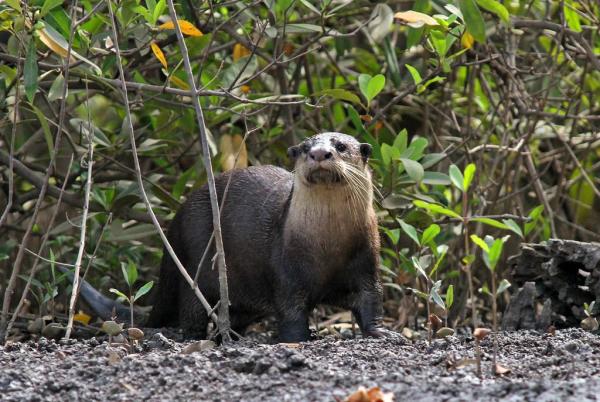
3. Sea otter (Enhydra lutris)
While various species of otter live in the marine environment, only one species is known as the sea otter. This is a marine otter distributed throughout coastal regions of Japan, Russia, Canada and the USA. Such a wide distribution has led to the recognition of three subspecies, determined by habitat:
- Asian sea otter (Enhydra lutris lutris): distributed throughout islands around Japan and Russia.
- Northern sea otter (Enhydra lutris kenyoni): found in the eastern Pacific Ocean of the Northern United States.
- Southern sea otter (Enhydra lutris nereis): native to California.
Sea otters develop in coastal areas, usually rocky areas with plenty of kelp. They can dive to depths of over 50 m, but they generally stay in shallow waters.
Although they are not the largest in length, they are the heaviest type of otter. They can weigh up to 100 lb and measure over 1.5 m in length. This is partly to their very thick coat which is used to protect them against the often very cold marine temperatures, something they need since they don't have any blubber. They feed on sea urchins, clams, mussels, octopuses, fish and other prey.
Despite being one of the most recognized types of otter, the sea otter is currently endangered. There has been great conservation effort to preserve them. This is very important as they are considered a keystone species. Their population loss will be to the wider detriment of their ecosystem. Threats have included their poaching, pollution (particularly from oil spills), predation from orcas and other reasons.
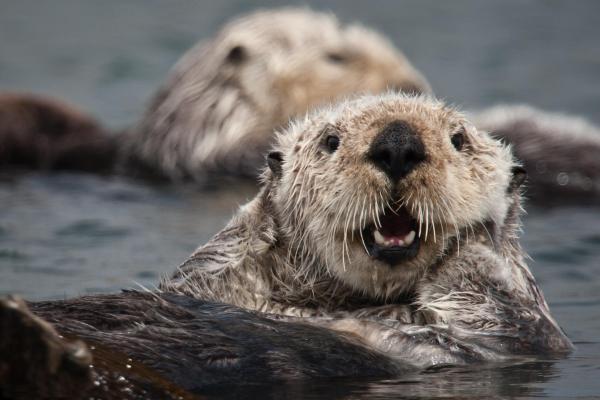
4. Spotted-necked otter (Hydrictis maculicollis)
This type of otter is distributed throughout southern Central Africa and humid areas of the sub-Saharan region. They are type of freshwater otter and live in unpolluted ecosystems which do not have sediment. This means they live in lakes, rivers, reservoirs and other open bodies of water.
They are a small otter species and have brown and white spots on their neck, from which their name is derived. They can measure up to 30" in length and weigh 14 lb. Although not currently considered endangered, this species is in decline. This is due to pollution, habitat destruction and its use as a type of bushmeat. No subspecies have been described, but the coloration and appearance of this species can vary greatly between different populations.
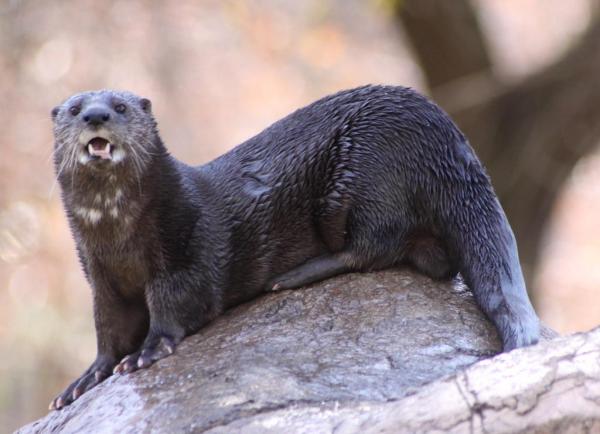
5. North American river otter (Lontra canadensis)
This type of river otter is native to Canada and the United States, although populations of unknown size have been recorded in Mexico. Known as the common otter, they are not considered endangered and have solid wild populations. This does not mean they don't have threats and some are still being poached for their fur.
Although a freshwater otter, the common otter can live in both freshwater and marine environments. They can withstand varying temperatures in rivers, lakes, seas, marshes, estuaries and swamps. What determines their location is the presence of food sources. It shares many spaces with the American beaver (Castor canadensis), the otter often being unintentionally trapped instead of the latter.
They have a long body which is well adapted for swimming. The fur is soft, between brown and almost black, but lighter in its ventral area. Their carnivorous diet is primarily based on fish, but also includes frogs, crayfish and birds, depending on the presence of such prey.

6. Southern river otter (Lontra provocax)
Some consider this species to be a subspecies of the North American river otter. However, they have their own tendencies and characteristics. Mainly considered a freshwater otter, they will also live in marine environments from time to time. Although mothers will spend time in a family group when they have young, they are largely solitary animals.
The southern river otter can grow over a meter in length and weigh up to 22 lb. They have been hunted for their fur for years and are considered endangered. They are found in temperate forests of Argentina and Chile, mainly in fresh waters to the north and marine environments in the south. It inhabits Andean lakes, lagoons, estuaries and rivers of various sizes. In marine ecosystems it is located towards the coast, since it does not move to open waters. In freshwater ecosystems it opts for those with the presence of abundant vegetation.
The southern river otter is medium in size and measures around one meter in length. The fur is velvety in texture and brown in color, except for the ventral region which is lighter. It is an aquatic forager, feeding on fish and crustaceans that it captures towards the bottom of the water.
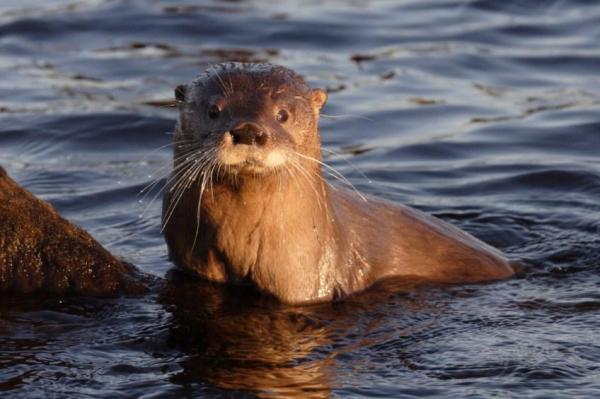
7. Marine otter (Lontra felina)
Although they have a similar name, the marine otter is a different type of otter from the sea otter. It is native to Argentina, Chile and Peru. Within the subfamily Lutrinae, it is the only species that exclusively inhabits marine ecosystems, in which it is quite agile. Its scientific name means ‘cat otter’ and is often known as the ‘sea cat’ in the Spanish countries it calls home.
When they do venture on land, marine otters can go up to areas 30 m above sea level, but can dive as far as 150 m below sea level. They mainly live in rocky areas with kelp forests, but they can move inland to rivers if searching for food. They feed mainly on crustaceans, mollusks, fish and small mammals. They are rare, considered endangered and protected by Peruvian, Chilean and Argentine governments.
The marine otter is not the only animal of its region with threatened populations. Find out more with our article on animals in danger of extinction in Peru.
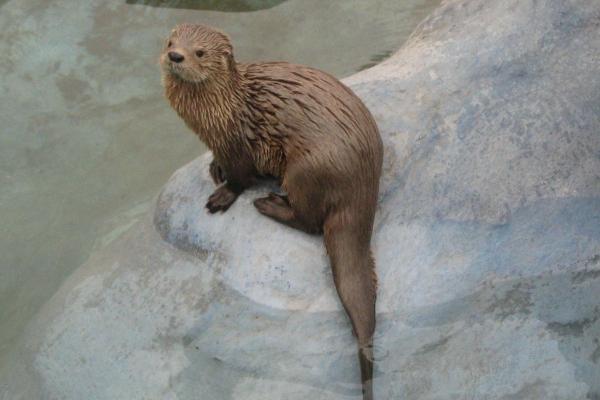
8. Neotropical otter (Lontra longicaudis)
This is a type of otter with a greater distribution than the previous American species. They inhabit areas ranging from the northeast of Mexico, extending through to Argentina in South America. They have not been reported in Chile. It is distributed in a variety of aquatic habitats including rivers, lakes, lagoons, marshes, mangroves and coastlines. Their habitat ranges from rocky marine areas to hot or cold forests, coastal savannahs and swamps.
They can weigh up to 33 lb and have a particularly long tail in relation to their body. They have a shiny greyish-brown coat, being lighter in color on the belly and throat. Due to the diversity of habitats in which it is located, it has an opportunistic diet, which includes fish, crustaceans, amphibians, mammals and birds. There are also at least six recognized subspecies of the neotropical otter.
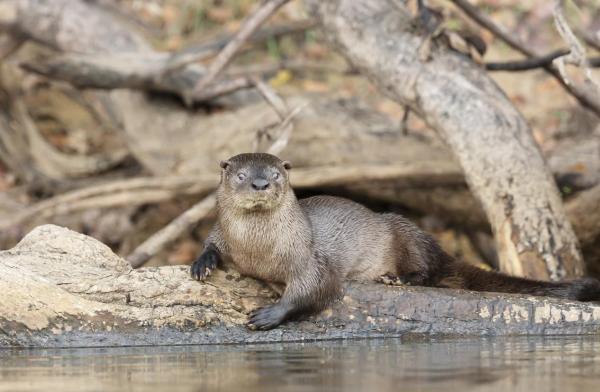
9. Congo clawless otter (Aonyx congicus)
Also known as the Cameroon clawless otter, this type of otter is not actually clawless. Instead, they have small blunt claws on their webbed toes. It is a large otter found in tropical regions of Central African Republic, Equatorial Guinea, Nigeria, Uganda, Rwanda and other African countries. It is easy to confuse them with the African clawless otter as the Congo clawless otter was once believed to be a subspecies of the former.
The Congo clawless water tends to feed on eggs, small vertebrates and amphibians. As with other otter species, they are often hunted as bushmeat and their pelts. Curiously, in Gabon, the Congo clawless otter has certain myths surrounding them. One belief is that catching them with a spear will result in them giving off an electric shock. Another is that wearing their pelt can confer the power of invisibility.
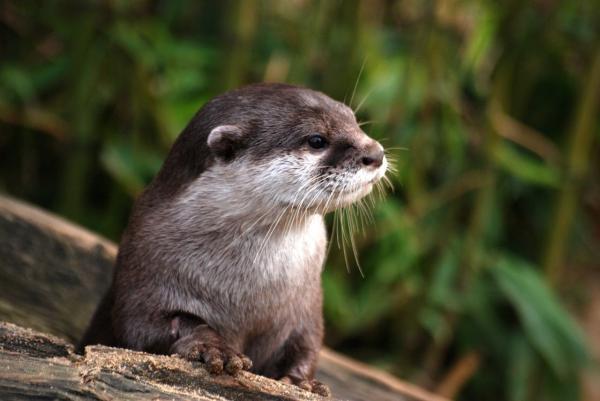
10. Eurasian otter (Lutra lutra)
Somewhat confusingly, this type of otter is also known as the European otter, but its distribution ranges throughout Europe, Asia and Africa. With such a wide distribution, it is unsurprising to know a variety of subspecies have been identified. Their habitats are equally diverse, including lakes, rivers, streams, swamps and coastal areas. They need aquatic environments to survive, but can also be found in areas up to 4,120 m in elevation.
Their color is brown with a white underside. They can measure over a meter in length if you include the tail and weigh over 30 lb. Fish represents over 80% of their diet, but they can also eat insects, small reptiles, birds and crustaceans. Unlike some other types of otters, they are very territorial and live on their own for the most part.
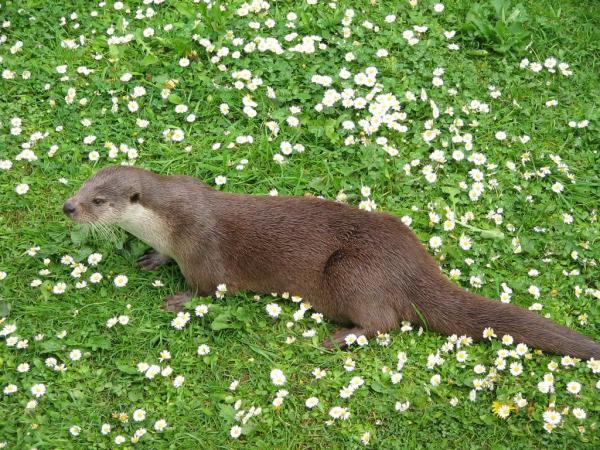
11. Hairy-nosed otter (Lutra sumatrana)
This type of otter is native to Asia, specifically from countries such as Cambodia, Indonesia, Malaysia, Myanmar, Thailand and Vietnam. The habitat is represented primarily by peat swampland, flooded areas and tropical forests.
Hairy-nosed otter fur is similar to many other species of otters, almost all brown except in the ventral area, which is lighter. However, they have a short layer of fine hair on their rhinarium which gives rise to their name. They can be solitary or live in groups of up to four individuals. They are the rarest otter in Asia and are considered endangered. Wild populations are hard to find and suffer from habitat destruction.
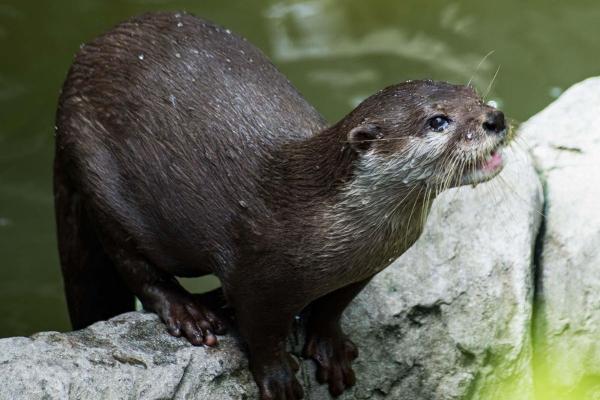
12. Smooth-haired otter (Lutrogale perspicillata)
This type of otter is distributed mainly in South Asia, but there is also a population in Iraq. It develops in plains and semi-arid regions, associated with large lakes and rivers. They also live in swampy peat forests, mangroves, estuaries and we have seen populations move to rice fields. Although they move easily through water, they are also agile on land.
The smooth-haired otter is the largest type of otter in the Southeast Asia region, weighing from 15-24 lb and measuring over a meter in length, if you include the tail. Their hair is shorter and shinier than most other otter species. The coloration ranges from dark to light brown, becoming even lighter towards the belly. Although they prefer to eat fish, their diet also includes insects, shrimp, crabs, rodents and frogs.
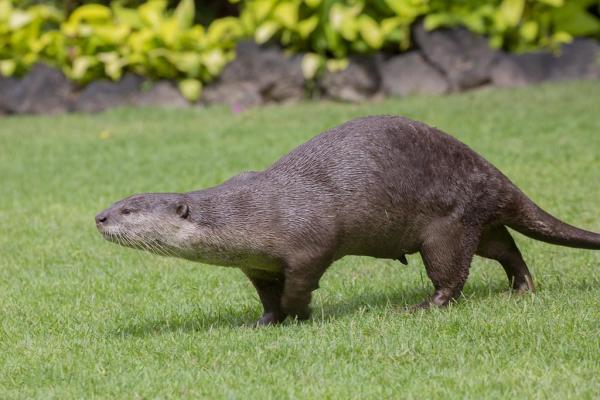
13. Giant otter (Pteronura brasiliensis)
The giant river otter is distributed in Bolivia, Brazil, Colombia, Ecuador, Guyana, French Guiana, Paraguay, Peru, Suriname and Venezuela. It inhabits freshwater ecosystems such as rivers, streams, lakes and swamps, which can have dark or clear waters, depending on the region.
The giant otter is distinguished from all other types of otters by being the largest and most sociable of these animals. The giant otter measures from 1 to almost 2 m in length, with weights ranging from 50 to 70 lb. Although some sea otters can be heavier, they are not larger. Their color is brown or reddish, with quite short fur. Although it is true they feed mainly on fish, they have been known to kill much larger alligators and other species of vertebrate animals.
With the giant otter, we finish our list of the different types of otters. You can see that too many of these beautiful animals are endangered or in threat of extinction. This is one of the many reasons we should stop trying to keep otters as pets and devote more energy to conservation. To learn more, take a look at our article on can you have otters as pets?
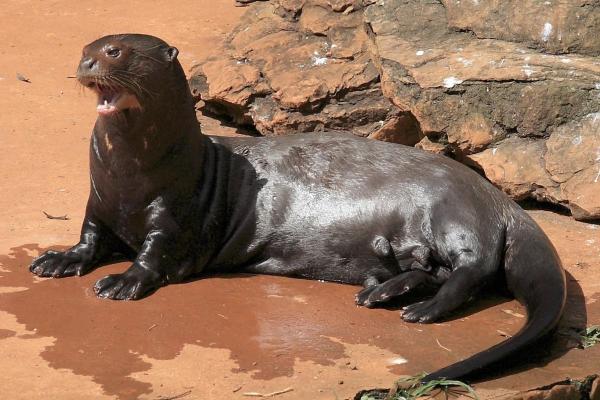
If you want to read similar articles to Different Types of Otters, we recommend you visit our Facts about the animal kingdom category.
- Animal Diversity Web. (2020). Retrieved from: https://animaldiversity.org/
- ITIS. (2022). Lutrinae. Retrieved from: https://www.itis.gov/servlet/SingleRpt/SingleRpt?search_topic=TSN&search_value=621910#null
- IUCN. (2022). The IUCN Red List of Threatened Species. Version 2021-3. Retrieved from: https://www.iucnredlist.org